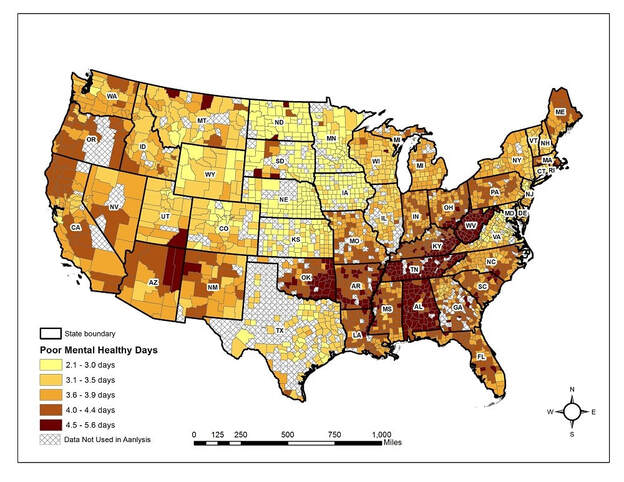|
9/16/2019 2 Comments Our new paper is published in the International Journal of Environmental Health Research Our new paper has been published in the International Journal of Environmental Health Research. In this paper, we examined potential factors that could affect community-level mental health across the United States. Here is the the summary:
"Mental health studies have underscored the hazardous conditions of each phase of life, from youth and pre-adulthood through adulthood in the United States. This situation calls for increased public awareness of the mental health issue and better understanding of the significant factors associated with mental health hazard. The main objective of this spatial epidemiological research is to gain greater insights into the geographic dimension displayed by the different duration of mentally unhealthy days (MUDs) across U.S. counties. Using Behavioural Risk Factor Surveillance System (BRFSS) data in 2014, we examine main factors of mental health hazard including health behaviour, clinical care, socioeconomic and physical environment, demographic, community resilience, and extreme climatic conditions. In this study, we take complex design factors such as clustering, stratification and sample weight in the BRFSS data into account by using Complex Samples General Linear Model (CSGLM). Then, spatial regression models, spatial lag and error models, are applied to examine spatial dependencies and heteroscedasticity. Econometric analysis underscores that all categories of air pollution, community resilience, and sunlight variables tested are significant push factors of mentally unhealthy days (MUDs) duration. Results of the geographic analyses indicate that counties with lower air pollution (PM2.5), higher community resilience (social, economic, infrastructure, and institutional resilience), and higher sunlight exposure had significantly lower average number of MUDs reported in the past 30 days. These findings suggest that policy makers should take air pollution, community resilience, and sunlight exposure into account when designing environmental and health policies and allocating resources to more effectively manage mental health problems." The following figure is from this paper (Ha and Shao 2019)
2 Comments
9/16/2019 1 Comment National Socio-Environmental Synthesis Center (SYSYNC) Postdoctoral Fellowship in 2020 The National Socio-Environmental Synthesis Center (SESYNC), located in Annapolis, Maryland, invites applications from early-career scholars (≤ 4 years post Ph.D.) for two-year postdoctoral fellowships that begin June 1, 2020. This postdoctoral fellow is expected to work with a Collaborating Mentor on "projects that have the potential to advance understanding of socio-environmental systems."
I am interested in serving as a Collaborating Mentor, working with a postdoc fellow on a range of topics that would fall within the socio-environmental systems. Specific topics could include: 1. social response to climate extremes 2. climate adaptation decision making 3. community resilience to environmental hazards in an urban setting or at a regional scale To learn more about this opportunity, please visit the SESYNC webiste. If you are interested in working with me, please send an email to me at wshao1@ua.edu. The website of my lab Environmental Decision Making at UA is up and running. Please check it out.
We encourage inquires from prospective Master of Science or Ph.D students with research interests in environmental decision making within a geographic context. In particular, we seek students with training in statistics, data analysis, quantitative methods, and Geographic Information System (GIS). Students' specific research interests can include: 1. environmental risk perceptions 2. individual adaptive behavior/intention 3. community vulnerability and resilience 4. environmental planning/policy 5. environmental hazards and public health If you are interested in joining us, please send your inquiry along with your CV., unofficial transcripts, test scores to Dr. Wanyun Shao at wshao1@ua.edu. |
|



 RSS Feed
RSS Feed